Here is a good practical question from a reader.
I have a question which you may well be able to answer, but that if you are too busy, I am pretty sure my fellow loyal readers of WDTPRS can.
What are the best practices for making the small linens for the altar?
I am good on the basics – what’s square and what’s rectangular, white color, and linen’s pride of place, but how much elaboration is good versus when it becomes a hindrance to proper purification. Where are the rules located? I haven’t found much at all. Recalling the wonderful pamphlet on the care of the linens, I am hoping for some guidance beyond common sense.
Good question. We do need the help of others for this. I have never made altar linens.
Here are some observations for my vantage of using them
First, keep them simple. Lots of elaboration, in my opinion, make them more difficult to use. There can be some embroidery around the edges of the corporal. Perhaps a very narrow band of lace or trim. The same for purificators, but only at the very ends. I would avoid doing (what ever it is called) that thing where you embroider around cut-out shapes. Pretty, but awkward to use. With a corporal I am always concerned that some particle will somehow fall through a hole.
Do make sure the fabric is absorbant, especially for the purificators. I have from time to time had to use nearly liquid resistant purificators. If a priest is diligent in purifying the chalice well, that’s pretty frustrating. I do like linen.
Altar cloths should ideally be long enough to reach close to the ground on either side of the altar. Remember that an altar really should have three cloths. The two beneath don’t have to reach the the ground, but they should cover the top. If you have an altar ad orientem and there are some contraptions designed to hold the altar cloths in place, you might think about reinforcing that side of the altar cloth. Not necessary, but it could be helpful.
This is a bit picky, but when making purificators you might consider the width of the chalice(s) for which you are making them so that they fit nicely across the top.
Here is a shot of how a corporal is sown up. This is one I am using now. It was made in Italy.
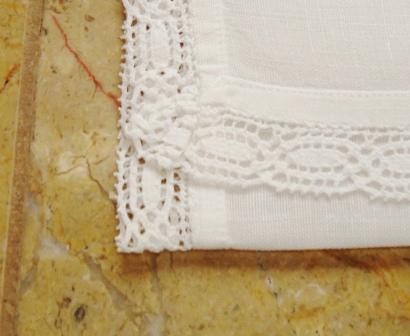
Keep purificators simple. Check the height of the chalice and the width of the cup.
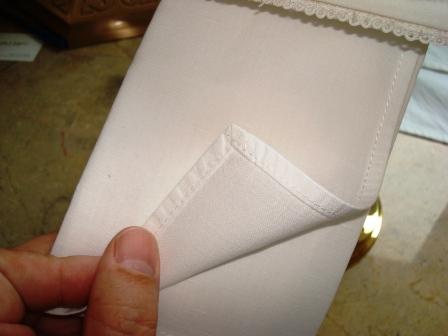
Remember that altar cloths are sometimes held down by gizmos.
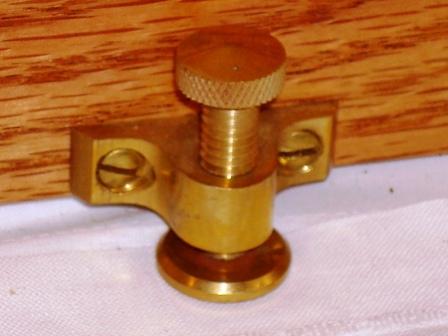
Palls can have some fancy work. I don’t prefer it, but I do use it from time to time. They are often made like a little flat bag or envelope in which you insert a stiff card. I HATE the Italian style pall, which is just a piece of starched cloth.
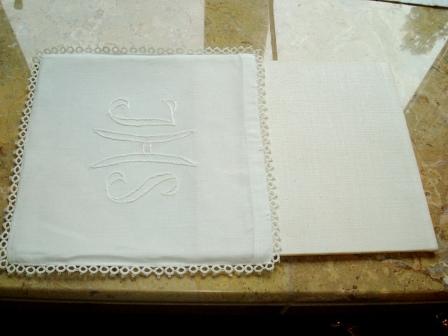
And the back.
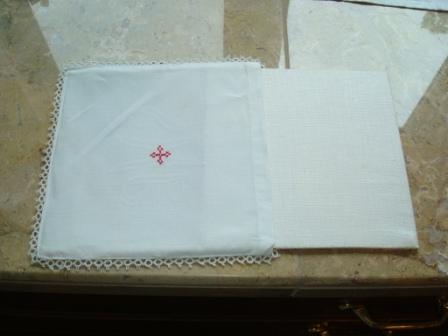
Maybe the reader with experience can chime in.


































Thank you, Father, for touching on this.
I often wonder if it would be a good thing–possibly for a girls’ club?–to make little things for the altar. The basic sewing–cut squares and rectangles, hem–is very simple to do. Especially since God invented the sewing machine. ;-) Also the rotary cutter, while we’re being grateful for technology, and the metal or plastic straightedge and cutting surface that go with it.
The style of lacy embroidery you dislike for this use is called cutwork. Also, with much smaller holes, eyelet or broderie Anglaise. (Often found in white ruffles.)
Talk a little more about the linen, please. Hankie weight? Light weight? details, details!!
God bless you.
Wow! Yesterday for the first time I washed and pressed the altar linens from my church. While doing so, I wondered how one would go about making some. I log onto Fr. Z. this morning and there is my answer. Are you psychic Father?
For those who can crochet.. there are various places ont he internet for free edgings. Some are more elaborate, others are quite simple.This is something Ive wanted to do for a very long time, but I know it would take me forever to complete- and I have other projects in my midst..lol
Here is a link to many different types..
http://www.crochetpatterncentral.com/directory/edgings.php
Two more free ones:
http://www.craftown.com/crochet/pat36.htm
http://www.angelfire.com/folk/celtwich/Altarlace9046.html
here a link for some beautiful patterns- they are fee based but the cost is very reasonable..
http://www.holyneedle.com/store/customer/home.php?cat=18
Here is a link to a parish in Portugal with some beautiful altar cloths…
http://www.tapestrycrochet.com/blog/?p=259
As far as absorbency goes, one should not ever use fabric softener on the altar linens because over time softeners (even dryer sheets) make the cloth less absorbent. If you’re concerned about scratchy purificators damaging the chalice, pour vinegar in the washer with the linens and then tumble dry. The vinegar will soften the fabric without effecting its absorbency.
Amy: What a great tip! Thanks!
These businesslike posts are fascinating.
I’m not very experienced in clothing (read: never done it), but I’ve been pondering learning how to make some chasubles for my parish priests. A modern chasuable doesn’t appear to be too difficult to construct, right? Of course, the challenge– like in this discussion of altar linens– is appropriate ornamentation. That part, of course, is the hardest part.
It may be a wiser gift of my time to consider a gift certificate to Aquinas and More. But daaaaaaaaaaaaaaaaaaang… chasubles are expensive!
WhollyRoamin’Catholic,
My wife and I, she an experienced seamstress, attempted vestment making once upon a time. Oy vey! I would never encourage anyone to get into that line of work, and my had is off to those brave enough to do it more than once.
It’s not as easy as it looks, and we easily spent in materials what we would have paid for one very nice piece from some of the better professional houses. Valuing our time at nothing, it was “cheaper”, but the final product was very sorry looking (think “homemade” and not “handmade”). It wouldn’t surprise me if the good father we gave them to hung them up and swore he’d never wear them…and neither of us would be hurt.
So, from my experience, just get together with several folks and have a nice set made by a professional house. It is worth the extra money.
Duly noted, Flambeaux.
Did you create your own pattern, or did you solicit any outside advice like from http://www.sewvestment.com?
Another suggestion, when washing linens, is to use powdered dishwashing detergent (like Cascade) instead of bleach. The bleaching capacity is similar, but the dishwashing detergent doesn’t wear down the threads as much as bleach does.
I offer that suggestion after a number of years working in restaurants where I had to wear white dress shirts that frequently got stained. My roommates and I at the time found that bleaching our shirts caused the threads of the buttons to decay quickly – Cascade works much better.
Also – to whiten older, yellowed linens, wash them, then freeze them (here in the northern climes, we can hang them out on the line in a month or so – elsewhere, just put them in the freezer). After a day or so, take them out of the freezer, rinse in hot water and dry – you’ll be surprised at how white they get!
Tim: More great tips! Thanks!
Remember that altar cloths are sometimes held down by gizmos.
Gizmo… is that the liturgical term for the illustrated piece of hardware? ;)
The Catholic Encyclopedia has an article describing how to wax the middle altar cloth. (Traditionally there are three altar cloths: one on the altar, a waxed cloth covering the top of the altar, and the top cloth that reached down to the floor.)
For ornamentation for chasubles, check with Almy. IIRC, they sell ophreys, etc. that can be applied to vestments. I believe they also sell vestments as kits that can be assembled by members of the parish altar guild.
You’re the best Father Z! Thanks for posting the question and thanks to all who have commented thus far.
I noticed on your corporal that the corners are no longer square. I fight this all the time with ours. I can pin block them to get them back true, but wondered if any other sewers have successfully found a way to match thread, trim, and fabric so that the shrinkage is even and the corners aren’t so prone to getting out of kilter. I love a pretty hem stitch or bit of lace at the edges, but hate parallelogram linens.
Nora: After a while they are no longer quite symmetrical. But that doesn’t bother me too much.
For both altar linens and vestments the secret is to invest in really top quality cloth. You are making something for years of use, not a throw-away fashion item. The better the cloth used for vestments, the less it needs any ornamentation other than braiding or really good orphreys
There are many places on the internet too where you can get free patterns for crocheted edgings.
Here are two you can google:
Crochet pattern central
a pretty vintage one
http://www.angelfire.com/folk/celtwich/Altarlace9046.html
and holyneedle.com has some filet designs as well as some beautiful cross stitch patterns that can be adapted to filet crochet
WRC,
We found a costume pattern for a gothic chasuble and stole from one of the major pattern companies and modified that. That was in…2003, IIRC.
One of the difficulties was not finding good fabrics in the width we needed to keep the vestments seamless. I’ve since realized, looking at chasubles produced by Almy, Gaspard, and others, that “seamless” usually isn’t really without seams. It merely has to appear that way from a distance.
Still, it isn’t something I’d ever want to attempt again.
“Do make sure the fabric is absorbant, especially for the purificators. I have from time to time had to use nearly liquid resistant purificators.”
Did someone slip a polyester purificator into your linen closet?
Slightly divergent question, as long as we’re discussing altar linens. Is there a guideline or actual standard as to how long the (top) altar cloth should be, and how it should be arranged? Specifically, should it go end-to-end (leaving the front of the altar exposed) or is it allowed to cover (hang down over) the front? Is there a standard as to how close to the floor it should reach?
My old home town parish church has a wooden altar, beautiful dark wood with graceful arching legs. The stain and the arc fit well with the patina and arc of the the timbers that serve as the columns and buttressing of the church.
For many years, the altar cloths were long, hanging down over each side, leaving the front exposed. Like a runner, but deep enough to cover the whole surface. More recently, someone took to using wider cloths that hung down in front (nearly to the floor), as well as the sides. There’s so much cloth one could hide a steamer trunk under it.
Here’s a (small, dark – but you can zoom) photo link of one arrangement.: http://www.stmarychurchnj.org/images/insidechurch_250.jpg
Hmmm. It looks like a third arrangement. I don’t remember the cloth being so short on each end, and I don’t remember the matching linens (corresponding to the vestments, I assume) hanging down the front/center of the altar and the anbo.
Father Z: I’m glad it doesn’t bother you as you offer the sacrifice.
It does bother me as I prepare the linens. When something leaves my hands to receive the Lord at the altar, I want every aspect of it to be as perfect as I hope to one day be perfect. I suspect that making the desire for God tangible by washing and ironing well is part of what being female means.
ok, i’m not getting paid for this (i should though), Oxyclean powder (not liquid) is much better than bleach for whitening dingy or yellowed fabric…it’s an oxygen bleach and you can use it with colors too. it’s really incredible. if you can forget the annoying commercials.
For those who are looking to buy fine, white linen cloth in order to make the various linens, I have found that the best source is eBay! One can buy 100% linen by the yard (in various weights) for cheaper than I’ve found elsewhere, and I have never had any problem with quality. [Great tip!]
I know what Nora C. means regarding the uneven shrinkage at the edges. My experience is that it is caused wherever the trim (or embroidery) is unevenly spaced in relation to the linen cloth. For example, in Father’s pic of his lace-edged corporal, the maker has bunched the lace around the corner, which looks pretty, but wears unevenly. Most people aren’t bothered by it, but if you’re so inclined to make your own, what I recommend is to do a sort of mitred corner on the lace trim instead of gathering it around the corner. That way, the flat edges of both linen and lace are kept together so that they shrink more evenly.
Regarding the uneven shrinkage, are you preshrinking the fabric before hemming it? Never made altar linens, just drawing on my quilting experience.
Or, test shrink a measured square, then cut the unshrunk fabric to slightly larger in the direction of the weave that shrinks the most.
a very helpful site that I found just by googling.. Lots of information here..
http://www.churchlinens.com
She has some beautiful work and materials.. WOW
there is even a link regarding the Tridentine Mass.. :)
A seamstress told me that one of the reasons that linens sometimes get misshapen (especially the cheaper store-bought ones) is because the cloth was not cut exactly with the grain. She told me that what she does, especially when using linen, is pulls a single thread out of the fabric so that she can cut a straight line with the grain, [good tip] and then hems/sews accordingly, and they always come out nice and square.
I have no idea how all of this works really, having had it only explained to me, but never having done anything like this myself.
Incidentally, I wish there were more women forthcoming who would volunteer to do things like linens (and also the harder stuff — like putting the pleats in a linen surplice properly, and putting the pleats in an alb, etc., stuff that the dry cleaners never do right [AMEN and AMEN] (and at too high a temperature also sometimes, so that it gets shiny), and also stuff that I have absolutely no time or patience to do myself!!!).
Daniel Latinus (et alii),
The “middle cloth” you refer to as waxed does not go in the middle, but directly on the stone mensa of the altar as a barracade to dampness and condensation or the oils used in consecrating a new altar. It is called a cere cloth. The three rubrical altar cloths go over the cere cloth. The first two cover the surface of the mensa. This may, in fact, be one cloth that is doubled. Properly, any decorative edging that hangs over the front of the altar is attached to this cloth, not the top cloth. Where the altar has an inset altar stone (usually a wooden altar) these two cloths need only be somewhat larger than the consecrated altar stone. The top cloth covers the altar from the back to the front edge and hangs to the floor on both ends. While it is customary to attach lace to this cloth, it is not proper to do so.
For making smaller altar linens it is best to use a heavier weight linen, especially for the purificator and finger towel. A somewhat lighter weight may be used for the corporal and pall, although “handkerchief” weight is a bit too thin and wears out quickly. Amices should be made of the same weight as the purificator as they sometimes require heavy laundering. Needless to say, high quality linen should be used in service of the altar.
The best way to cut and fold the hems to be sewn is on a drawn thread rather than marking the fabric. This will help to keep the pieces square. Hems should be double folded so that no raw edges show. Corners should be mitered so that there is no excess bulk. [Good tips]
Each piece requires a small red cross embroidered in a different place. Check with your priest as to the placement. [RIGHT] These crosses are not decorative, but are to distinguish one linen from the other or, in the case of the amice, to indicate where it is kissed before vesting.
Lace can be difficult to launder so is better left off. It often becomes torn and shabby looking. It can be added to the pall, but should be basted on so that it can be removed for laundering. It should be pure white. Never use gold, silver, or colored lace. A benediction corporal may also have a lace edge that is basted on. [“may”…. okay… well… I think we can be flexible abou these things. I prefer simplicity, but there is room for a fancier approach for perhaps one set of linens for the most solemn occasions.]
With regard to lace:
I really do not like it to be used on either purificators or corporals personally, because it seems to me that it is always possible for a particle of the Blessed Sacrament to end up caught in it on the corporal or snagged by it on the purificator. I much prefer plain-edged linens (the amice can have some lace edging on it, but I never really understood the purpose of this either, since you don’t see any of it…). [Agreed.]
I have seen very nice linens with rich lace edgings (EWTN sometimes uses them, for example), but I would rather see the fancy decoration on the alb, vestments, altar cloth, tabernacle veil, ciboria veil, etc. Let the linens be simple. [Agreed.]
That said, I do have a linen set with some very nice embroidered fleur-de-lys on them. Embroidery is different — although one has to be careful also, I think, not to have too much embroidery, particularly when one is celebrating the Extraordinary Form and has to scrape down the corporal with the pall when purifying everything (note that this could technically be done in the Ordinary Form also…). Embroidery gets in the way of scraping. [Yes.]
This is an interesting thread! [It sure is!]
Father,
A most interesting post. I once asked some knowns the secret of their ironing altar linen and wimples. “Did they use starch?” I asked.
The secret [and they were still using a vast collection of old-fashioned flat-irons,of assorted weights and sizes, heated on a special tortoise stove in the convent laundry] was “Wet & iron, Wet & iron”.
And, d’y’know, it works: with a very hot iron a nice gloss and stiffness results. So much so, that a propos your comment
“Palls can have some fancy work. I don’t prefer it, but I do use it from time to time. They are often made like a little flat bag or envelope in which you insert a stiff card. I HATE the Italian style pall, which is just a piece of starched cloth.”
a linen pall [made up of three layers of linen – is this similar to your Italian pall?] will be stiff as card, but without starch.
I agree that the purse type are convenient, but much prefer to cardboard a thin piece of “ivorine” or perspex type material, which is easily cleaned with a damp purificator should anything untoward occur to mark the pall.
Glad you enjoyed your stay in the UK.
Keep up the good work,
Regards,
John UK
Fr. Scott Bailey, C.Ss.R. – “Where the altar has an inset altar stone (usually a wooden altar) these two cloths need only be somewhat larger than the consecrated altar stone. The top cloth covers the altar from the back to the front edge and hangs to the floor on both ends.”
Father, thank you! It seemed obvious when considering an altar that might have something like a relief of the Last Supper on the front. I couldn’t be sure if I was simply being an architectural snob to like it one way opposed to the other. It’s nice to hear there’s some basis in practice for what I thought. Any chance you or Father Z. could suggest a reference work on the topic?
This being a wooden altar I mentioned, I do remember it having an inset stone.
Details like this and the linens are slowly coming back to me. It’s been a long time since I was “vice-president” of the Rosary Altar Society.
OOps! Mea Culpa
I do not know how nuns came to appear as “knowns” the penultimate post, unless because they were all-knowing in matters of liturgical laundry!
I am sorry.
John UK
I, as a crocheter and knitter of lace have to agree with keeping the trims on altar linens to an absolute minimum. Albs, large altar linens, rochets, exc, that don’t have to take quite the same kind of use as the smaller linens, can get away with a bit more fanciness and decore.
I am currently filet crocheting a piece of work for my chuch and find the work fun and holy. When something is done for God’s glory and that alone, it just fills up the soul like nothing else can.
“Fr. Scott Bailey” and “Priest” are both absolutely correct about cutting and hemming on a “drawn thread” rather than by marking. It is an easy and foolproof way of squaring the linen. (Just make sure you do it on all four sides!)
And mitred corners not only cut down on bulk, but they look better, too! They are worth the bit of extra time.
Fr. Scott, we have some linens with red crosses and some with white. Are the white ones incorrect? As for placement, I will certainly show our pastor what is planned before executing it, but is there a guide somewhere? I know we have corporals with two different cross placements: some in the middle and some in square 8 (bottom middle). Father’s amices do not have an embroidered cross. Where should that be? Also he has mentioned that there should b five crosses on the top altar cloth over the relics in the stone. Is there guidance on those?
…so many questions, such joy!
Nora, white thread is often used to embroider the crosses on the linens, though everything I have red specifies red. One practical reason for using red is that they are more visible. White on white can be hard to see, especially for those who have vision problems.
The cross on the corporal is to go along the front edge in the middle (“square 8”). If it is in the center of the corporal (“square 5″) it impedes the gathering of any fragments of the Most Holy.
The cross on the amice should go in the middle about two inches in from the top edge (the one the tapes are swen to).
The cross on the purificator goes in the center.
The cross on the pall goes in the center, though it is not required. The top of the pall may be embroidered with any appropriate symbol. The bottom of the pall (the side which touches the chalice) is not to be embroidered.
The cross on the lavabo towel is usually placed on the bottom right corner. Though this also is not required by law, it is very helpful when laundering linens as lavabo towels and purificators can often be confused.
There is no requirement for a cross to be embroidered on the altar cloth, although it is helpful to centering it if there is one placed in the center of the back edge. The custom of embroidering 5 crosses is used in the Anglican Church but is not general Catholic practice. There is, however, nothing to forbid the practice. They are placed in the four corners and the center and are about 1.5″ x 1.5”. Care must be taken that they are not too thick, especially the center one, as this may cause the chalice to be unsteady. My suggestion is not to use them if at all possible.
Many years ago Maryknoll put out a booklet on sweing and laundering altar linens but I haven’t seen it since I was a sacristan in the seminary.
Thank you to everyone who does this great work.
Charivari Rob,
At times, such as occasions of great solemnity, it is appropriate to cover the front of the altar with a decorative antipendium or frontal. This is especially true of plain altars with no carving or decoration beneath them. In this case free-standing altars should be covered on all sides if they can be viewed by the people.
These days, however, the “anything goes” mentality pervades and often these things are not thought out. To cover a free-standing altar to the floor on all sides is certainly appropriate. However one should consider whether this is necessary or not for a particular occasion or setting. On the other hand, there are some altars that are so lack artistry that they should be done away with never mind be covered.
The use of pulpit or ambo hangings is also appropriate. However, they should be well and artistically made. Today one often sees “sets” of altar hangings that are simply not worthy of the sacred liturgy.
One final suggestion:
Lets make an effort to go back to using vesperal cloths, a.k.a. dust covers or coverlets. They go a long way to keeping the altar cloths clean and free of debris. In days past they were often red or green. There is no reason they cannot be white, and since they need only cover the mensa of the altar they won’t detract from the appearance of the altar outside of Mass times.
Thanks again! I had always wondered what was the proper term for my beloved dust cover. I use a section of fair linen that is really too short to be an altar cloth for us. I don’t like the colored ones because they can leave fibers behind on the white. Using the vesperal cloth (I know knowing stuff!) cuts down on the need to wash (and IRON) 12 feet of linen. I’ll keep an eye out for tha Maryknoll book.